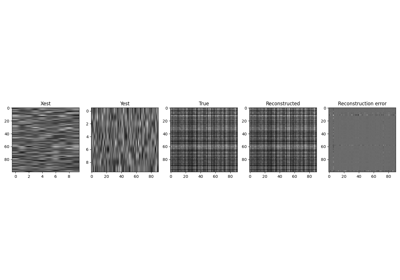pyproximal.optimization.palm.PALM#
- pyproximal.optimization.palm.PALM(H, proxf, proxg, x0, y0, gammaf=1.0, gammag=1.0, niter=10, callback=None, show=False)[source]#
Proximal Alternating Linearized Minimization
Solves the following minimization problem using the Proximal Alternating Linearized Minimization (PALM) algorithm:
\[\mathbf{x}\mathbf{,y} = \argmin_{\mathbf{x}, \mathbf{y}} f(\mathbf{x}) + g(\mathbf{y}) + H(\mathbf{x}, \mathbf{y})\]where \(f(\mathbf{x})\) and \(g(\mathbf{y})\) are any pair of convex functions that have known proximal operators, and \(H(\mathbf{x}, \mathbf{y})\) is a smooth function.
- Parameters
- H
pyproximal.utils.bilinear.Bilinear Bilinear function
- proxf
pyproximal.ProxOperator Proximal operator of f function
- proxg
pyproximal.ProxOperator Proximal operator of g function
- x0
numpy.ndarray Initial x vector
- y0
numpy.ndarray Initial y vector
- gammaf
float, optional Positive scalar weight for
ffunction update- gammag
float, optional Positive scalar weight for
gfunction update- niter
int, optional Number of iterations of iterative scheme
- callback
callable, optional Function with signature (
callback(x)) to call after each iteration wherexandyare the current model vectors- show
bool, optional Display iterations log
- H
- Returns
- x
numpy.ndarray Inverted x vector
- y
numpy.ndarray Inverted y vector
- x
Notes
PALM [1] can be expressed by the following recursion:
\[\begin{split}\mathbf{x}^{k+1} = \prox_{c_k f}(\mathbf{x}^{k} - \frac{1}{c_k}\nabla_x H(\mathbf{x}^{k}, \mathbf{y}^{k}))\\ \mathbf{y}^{k+1} = \prox_{d_k g}(\mathbf{y}^{k} - \frac{1}{d_k}\nabla_y H(\mathbf{x}^{k+1}, \mathbf{y}^{k}))\\\end{split}\]Here \(c_k=\gamma_f L_x\) and \(d_k=\gamma_g L_y\), where \(L_x\) and \(L_y\) are the Lipschitz constant of \(\nabla_x H\) and \(\nabla_y H\), respectively.
- 1
Bolte, J., Sabach, S., and Teboulle, M. “Proximal alternating linearized minimization for nonconvex and nonsmooth problems”, Mathematical Programming, vol. 146, pp. 459–494. 2014.

